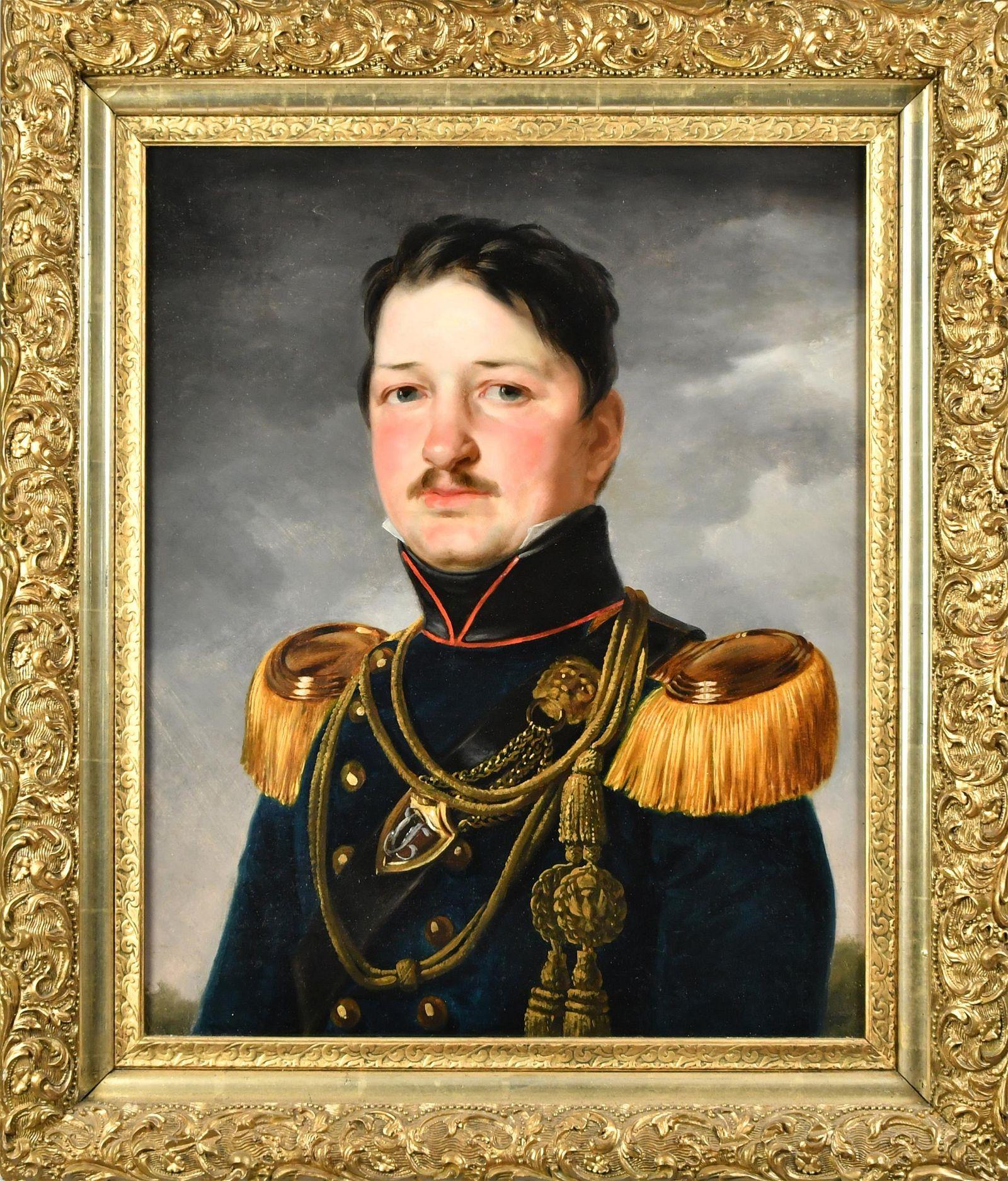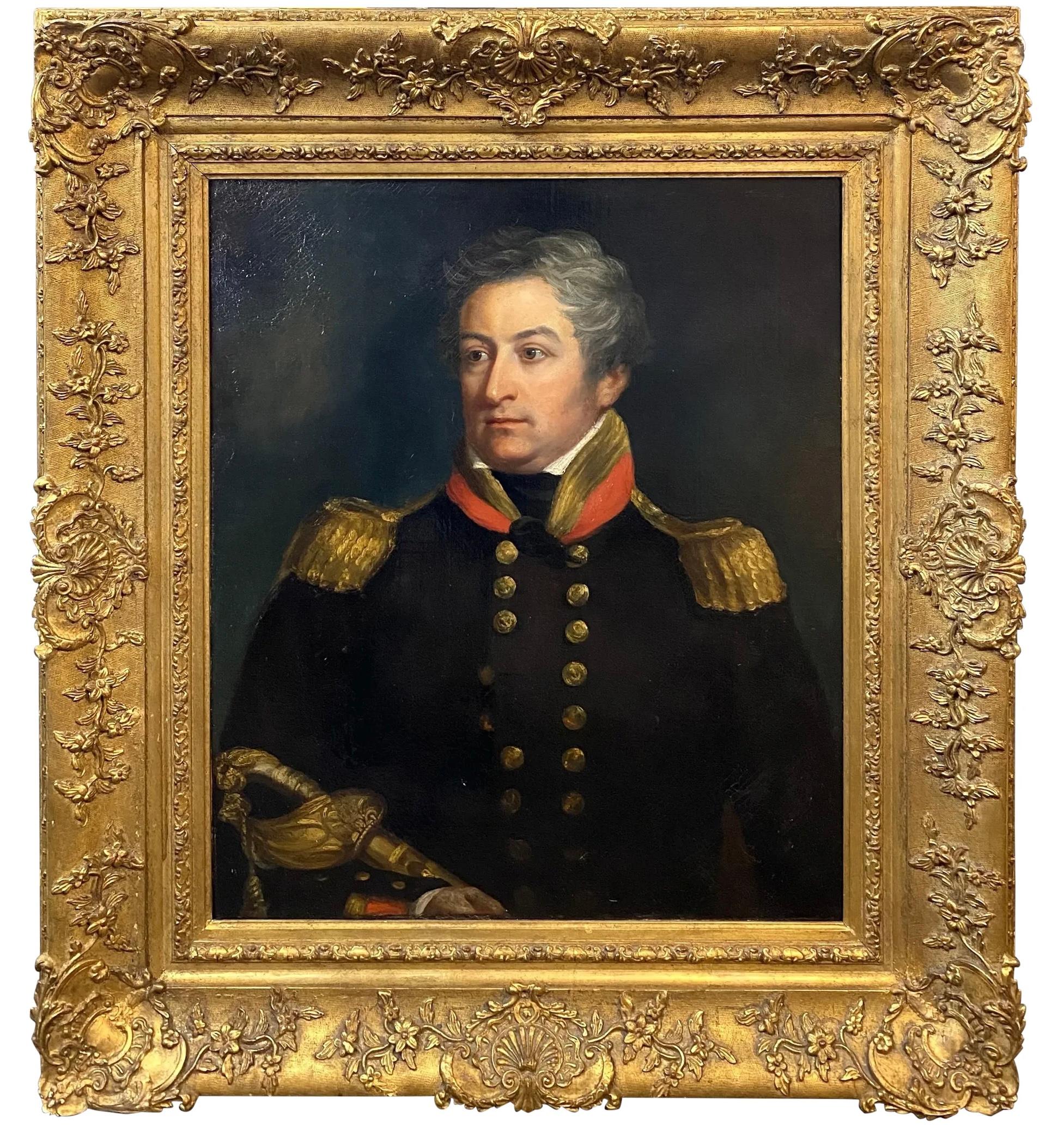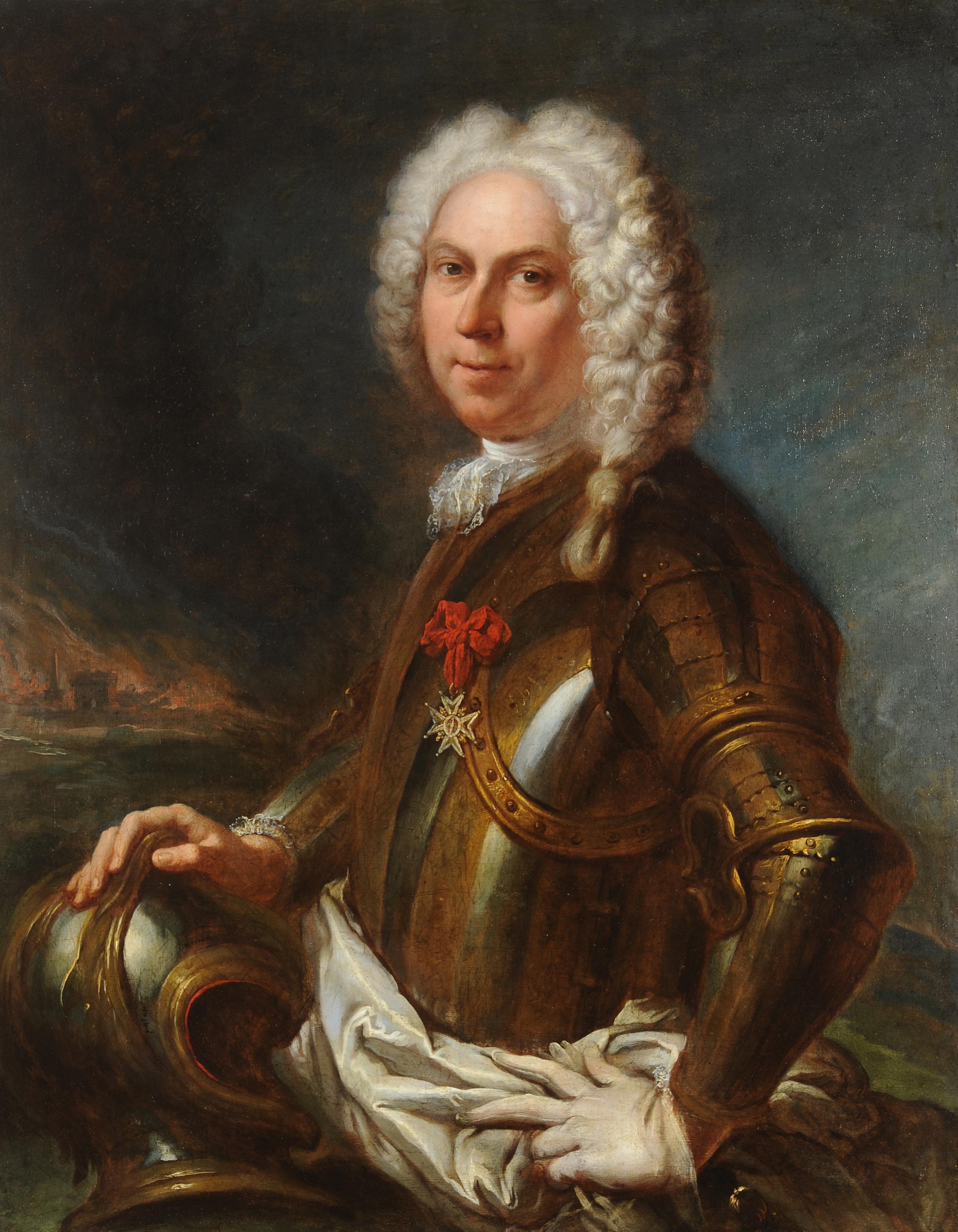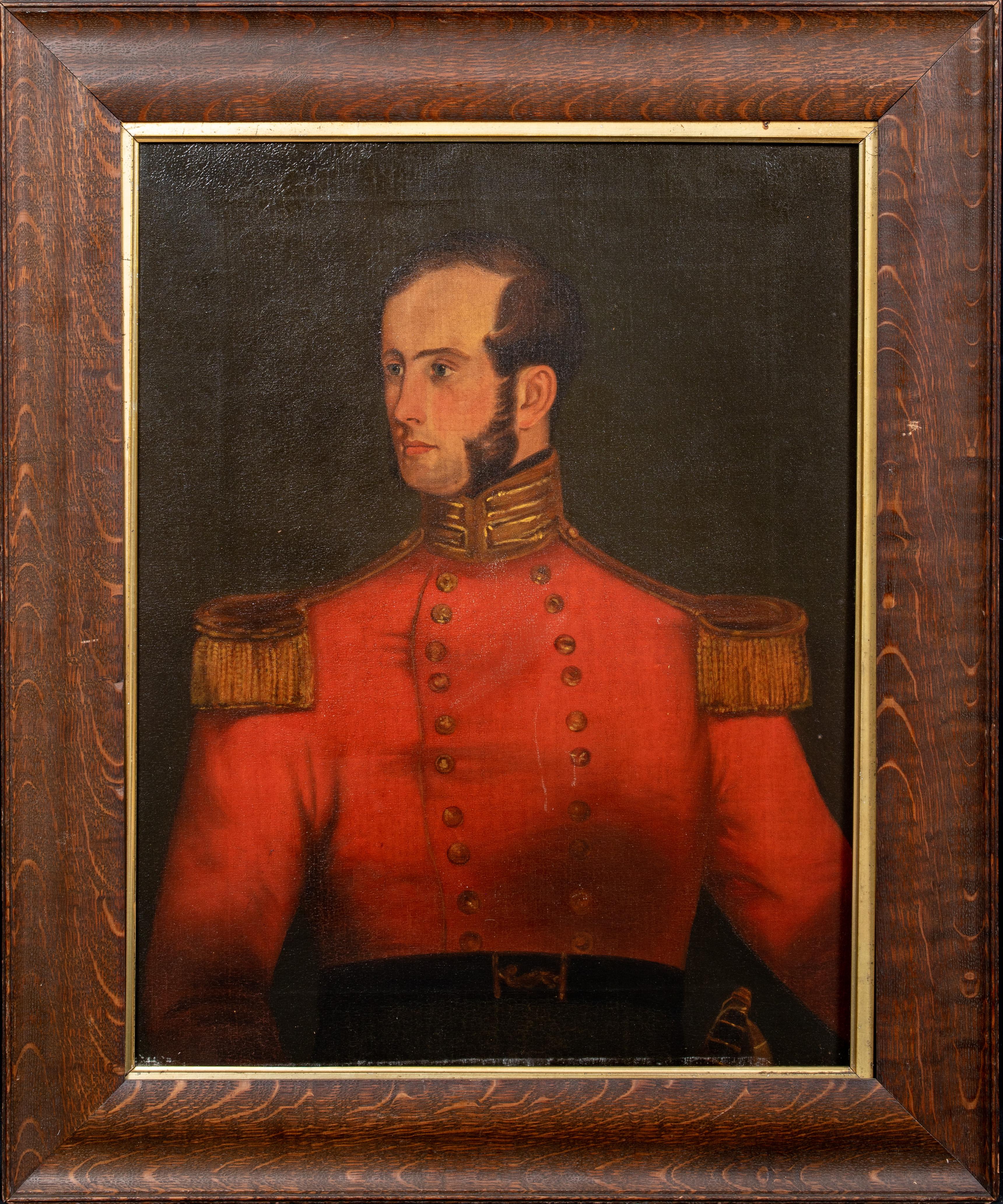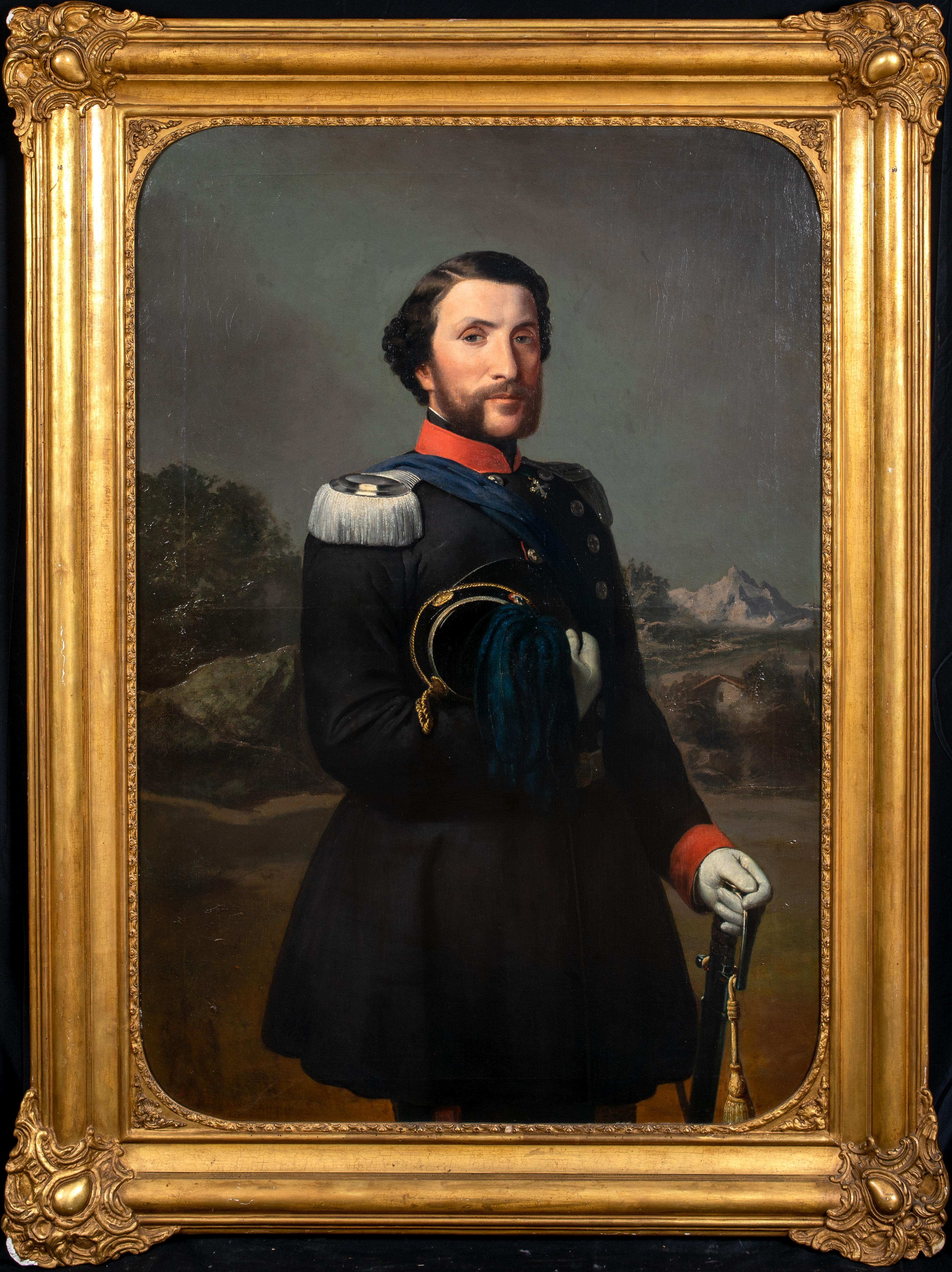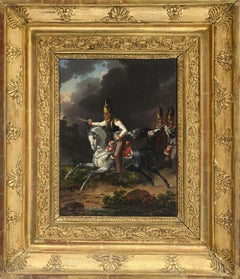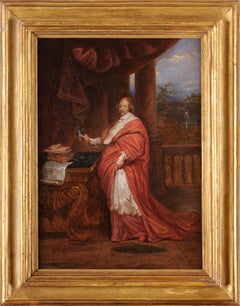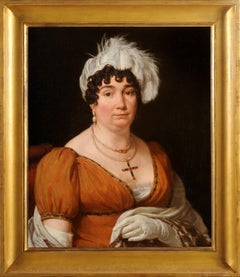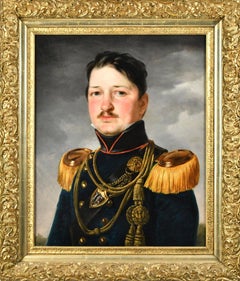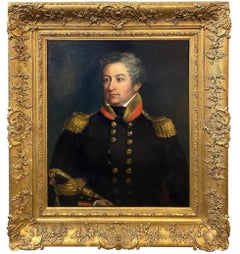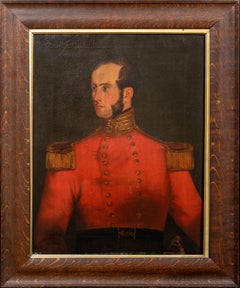Items Similar to Portrait of baron de Roisin - Gendarmerie general
Want more images or videos?
Request additional images or videos from the seller
1 of 9
UnknownPortrait of baron de Roisin - Gendarmerie generalCirca 1835
Circa 1835
$8,953.01
£6,643.60
€7,500
CA$12,486.86
A$13,526.35
CHF 7,122.18
MX$164,182
NOK 88,822.48
SEK 83,979.57
DKK 57,109.47
About the Item
Flemish school of the 19th century
Armorial portrait of Baron Henri de ROISIN (1787-1846)
in the uniform of a general of the gendarmerie (1835)
Oil on canvas
H. 108 cm; W. 90 cm
Baron Baudry-Ghislain-Adrien-Henri de Roisin, born on September 23, 1787 at the castle of Rongy, is a Dutch general and politician. Henri de Roisin is the son of Baudry, Baron de Roisin (1760-1829), officer in the service of Austria, chamberlain of the King of the Netherlands, lord, mayor and burgomaster of Rongy, and of Flore de Rodoan (1758-1832). First an officer in the service of France from 1807 to 1814 then in the service of the allied armies (1814-1815), he placed himself for the rest of his career in the service of the King of the Netherlands between 1815 and 1839. Then becoming a major of cavalry and aide-de-camp to the King of the Netherlands, then lieutenant-colonel in the light dragoons, he was elected deputy of the Provincial States of Hainaut (1821-1822) then member of the second Chamber of the States General of the Kingdom of the Netherlands for the province of Hainaut from 1823 to 1830. Colonel of the staff of the Prince of Orange, then major-general of cavalry in the service of the King of the Netherlands until 1839, he then left the service and became mayor of Rongy. He was made a knight of the Lion of Belgium. On June 2, 1825, he married Alexandrine Ferdinande de Meldeman de Bouré (1807-1863) and from this union was born an only daughter Flore de Roisin (1826-1902). Henri de Roisin died on March 21, 1846 in his castle of Rongy at the age of 58.
- Creation Year:Circa 1835
- Dimensions:Height: 42.52 in (108 cm)Width: 35.44 in (90 cm)
- Medium:
- Movement & Style:
- Period:
- Condition:
- Gallery Location:BELEYMAS, FR
- Reference Number:1stDibs: LU1857215701662
About the Seller
3.0
Vetted Professional Seller
Every seller passes strict standards for authenticity and reliability
Established in 2017
1stDibs seller since 2022
5 sales on 1stDibs
- ShippingRetrieving quote...Shipping from: BELEYMAS, France
- Return Policy
Authenticity Guarantee
In the unlikely event there’s an issue with an item’s authenticity, contact us within 1 year for a full refund. DetailsMoney-Back Guarantee
If your item is not as described, is damaged in transit, or does not arrive, contact us within 7 days for a full refund. Details24-Hour Cancellation
You have a 24-hour grace period in which to reconsider your purchase, with no questions asked.Vetted Professional Sellers
Our world-class sellers must adhere to strict standards for service and quality, maintaining the integrity of our listings.Price-Match Guarantee
If you find that a seller listed the same item for a lower price elsewhere, we’ll match it.Trusted Global Delivery
Our best-in-class carrier network provides specialized shipping options worldwide, including custom delivery.More From This Seller
View AllPortrait of a man in armor
Located in BELEYMAS, FR
Attributed to Jacques DUMONT aka DUMONT LE ROMAIN
(Paris 1701 - 1781)
Presumed portrait of Louis-Joseph de Formanoir (?-1732)
Oil on canvas
H. 91.5 cm; L. 73 cm
Signed on the helmet:...
Category
1750s French School Portrait Paintings
Materials
Canvas, Oil
Portrait of Russian cuirassiers colonel
By Hippolyte Lecomte
Located in BELEYMAS, FR
Hippolyte LECOMTE
(Puiseaux, 1781 – Paris, 1857)
Colonel of Russian cuirassiers
Oil on canvas
H. 33 cm; W. 24 cm
Signed and dated at the bottom towards the center 1817
Exhibition: S...
Category
1810s French School Animal Paintings
Materials
Oil, Canvas
Cardinal Mazarin portrait
Located in BELEYMAS, FR
French School circa 1645
Portrait of Cardinal Mazarin - Sketch
Oil on canvas
H. 41.5 cm; W. 27 cm
Provenance: Collection of the Reverend Georges Downing Bowles (1789-1863)
Would ...
Category
1640s French School Portrait Paintings
Materials
Canvas, Oil
Portrait of Madame Leblond
Located in BELEYMAS, FR
French school circa 1815
Portrait of Madame Leblond
Oil on canvas
H. 66 cm; W. 55 cm
Named on the back
Comparable to the works of painters such as Louis Hersent, our portrait, unsig...
Category
1810s French School Figurative Paintings
Materials
Canvas, Oil
Portrait of a man during French Revolution
Located in BELEYMAS, FR
Antoine VESTIER, attributed to
(Avallon, 1740 - Paris, 1824)
Portrait of a man under the Revolution
Oil on canvas
H. 46 cm; L. 37 cm
Circa 1793-95
This beautiful unsigned portrait i...
Category
1790s French School Figurative Paintings
Materials
Canvas, Oil
Presumed artist self-portrait
Located in BELEYMAS, FR
Louis-Gabriel BLANCHET
(Versailles, 1701 – Rome, 1772)
Presumed self-portrait of the artist
Oil on canvas
H. 73 cm; W. 60 cm
Circa 1730
Originally presented in a Restoration period frame with a "Mignard" cartouche, this beautiful painting initially appeared to us as a work from northern Italy. However, it exuded a rather French form of refinement, suggesting that its artist may have assimilated a dual influence from both sides of the Alps.
We thank our colleague and friend Philippe Mendès for spontaneously and judiciously "bringing out" the name of Louis-Gabriel Blanchet, a Romanized French portraitist, whose spirit and stylistic characteristics we clearly recognize here.
Blanchet's "French" years, before his final departure for Rome in 1728, following his winning of the second Grand Prix for painting after Subleyras in 1727, are extremely poorly documented. His father, Gabriel, was valet to Blouin, himself Louis XIV's first valet at the time. According to Thierry Lefrançois, Blanchet was one of the few students of Nicolas Bertin (1667-1736), whose studio he is said to have joined in the early 1720s. At a baptism on March 24, 1724, where he was godfather, he is mentioned as a painter in the picture store of the Duke of Antin, the director of buildings between 1708 and 1736. At this time, he was probably already married to Jeanne Quément, with whom he had a daughter also named Jeanne, who would marry Nicolas Aviet, the son of a valet in the queen's wardrobe, in Versailles in 1738.
When Blanchet arrived in Rome in October 1728, he was accompanied by Subleyras, Trémolières, and Slodtz. He enjoyed the goodwill of Vleughels, the director of the Académie de France, which had been based at the Palazzo Mancini since 1725, even though the latter was not always kind to our resident. From 1732, he was under the protection of the Duke of Saint-Aignan when he took up his post as ambassador to Rome. Along with Slodtz and Subleyras, they formed a trio of friends, joined by Joseph Vernet shortly after his arrival in Rome in 1734. Slodtz and Blanchet, on the occasion of Subleyras's marriage in 1739, were there to attest that their friend was not bound by any marital commitment, and Blanchet was a witness at Vernet's wedding in 1745.
It is most likely from these early years in Rome that our portrait of the artist dates, the expression and turn of his face irresistibly reminiscent of a self-portrait. The still relatively youthful features may correspond to Blanchet's thirty-something years, and the fluffy wig was still fashionable at this time.
The painting fits well with the depiction of a young painter wanting to display both the beginnings of success and a certain simplicity or restraint. A slight smile expresses a form of assurance in this man with a gentle, sincere gaze and a face radiating a keen sense of wit. We find here the air of intimacy present in almost all of Blanchet's portraits, even those from the 1750s and 1760s, as well as an almost complicity with the viewer. The spirit of the painting is quite close to that of the presumed portrait of Bouchardon (painted around 1730) and the portrait of Pannini, painted in 1736, but it possesses a more natural quality, notably thanks to the absence of decorum. Our work exhibits the characteristics of Blanchet's paintings: elegance, luminosity (especially in the whites), vibrant and refined colors (here, the harmony of the garnet of the garment and the slate blue of the background, whose uniformity is tempered by a very sketched landscape and a grove of greenery), light complexions, rather rosy cheekbones, often full lips, and rather tight framing.
According to the Academy's rules, Blanchet's stay should have ended in the spring of 1732, but, for reasons unknown, he remained in the Eternal City until his death, as did his friend Subleyras, with whom he shared accommodation until the late 1730s. The latter regularly called upon him to collaborate on his paintings, such as The Meal at Simon's. Through Saint-Aignan's intervention, Blanchet was employed in the late 1730s by the Stuart princely family, then exiled in Italy. He notably produced copies (now lost) after Liotard of the portraits of Charles Edward and Henry Benedict, the sons of James III Stuart. The latter also commissioned three other portraits (now in the National Portrait Gallery in London), whose more formal character contrasts with the intimate spirit of Blanchet's portraits. Blanchet frequented English painters, such as the landscape painter Richard Wilson, and studied with the Scottish portraitist Katherine Read...
Category
1730s French School Portrait Paintings
Materials
Oil, Canvas
You May Also Like
European Portrait Of A Military General
Located in Lake Worth Beach, FL
Portrait of a Military General
Fine 19th C European, Neo -Classical half-length portrait of a Military General, a handsome man wearing military regali...
Category
Mid-19th Century French School Portrait Paintings
Materials
Canvas, Oil
Portrait of Colonel Charles-Louis-Prosper Marquis de Chérisey (1786-1837)
Located in Paris, IDF
After Louis-Stanislas MARIN-LAVIGNE (Paris, 1797 – Paris, 1860)
Portrait of Colonel Charles-Louis-Prosper Marquis de Chérisey (1786-1837)
in the uniform of commander of the 38th lin...
Category
Mid-19th Century French School Portrait Paintings
Materials
Oil
Portrait of a French Military Officer
Located in Milford, NH
A finely detailed oil painting portrait of a French military officer in dress uniform with sword, unsigned, and housed in a period decorative gilt gessoed frame with a London Freeman...
Category
Early 19th Century Portrait Paintings
Materials
Canvas, Oil
Portrait Of A British Officer, early 19th Century - Napoleonic Wars Era
Located in Blackwater, GB
Portrait Of A British Officer, early 19th Century
Napoleonic wars Era
Early 19th Century Napoleonic Wars Era portrait of a British military officer, oil on canvas. Excellent quality and condition portrait of the officer in his red tunic...
Category
Early 19th Century Portrait Paintings
Materials
Canvas, Oil
$2,639 Sale Price
20% Off
Portrait Of An Officer Wearing The Order of Saints Maurice and Lazarus, 1860
Located in Blackwater, GB
Portrait Of An Officer Wearing The Order of Saints Maurice and Lazarus, circa 1860
circle of Giuseppe Ugolino (1826-1897)
Huge mid 19th Century Italian portrait of an Officer wearing the Order Of Saint Maurice and Lazarus, oil on canvas. Important early military portrait from the Italian Wars Of...
Category
Early 19th Century Portrait Paintings
Materials
Canvas, Oil
$10,446 Sale Price
20% Off
General Wilhelm von Blume - Visionary retrospective -
Located in Berlin, DE
Bernhard Pankok (1872 Münster - 1943 Baierbrunn), General Wilhelm von Blume, 1915, aquatint etching, 34 x 29.5 cm (sheet size), 26 x 22 cm (plate size), signed in the plate at upper left, in pencil at lower right and dated in pencil at lower left.
- At lower left old collection stamp, at the right broad margin with a small spot, otherwise very good condition.
About the artwork
The 1915 aquatint etching of General Wilhelm von Blume is based on a 1912 oil painting in the LWL-Museum für Kunst und Kultur in Münster. A second oil portrait of the general by Pankok is in the Staatsgalerie Stuttgart. When Pankok painted the first oil portrait in 1912, the general had already been retired for 16 years. It is therefore a retrospective portrait. Accordingly, the orientation of his head is such that he is looking back in both the oil painting and the etching. Without fixing on anything in particular, he looks thoughtfully inwards and reflects on his life. Uniformed and highly endowed, it is his military activities in particular that he is reviewing attentively and, as his gaze reveals, quite critically.
Pankok has literally written the sum of his experiences on Wilhelm von Blume's face: The physiognomy is a veritable landscape of folds, furrows, ridges and gullies, all the more striking against the flat background. It is clear that each of the medals was also won through suffering. However, by breaking the boundaries of the picture, his bust appears as an unshakable massif, which gives the general a stoic quality.
The fact that the design of the portrait was important to Pankok can be seen from the different versions, the present sheet being the third and probably final revision, which Pankok dates precisely to 18 February 1915. Compared with the previous state, the light background now has a dark area against which the sitter's face stands out, the dark background in turn combining with the uniform to create a new tension in the picture.
Pankok's taking up of the portrait of the high-ranking military veteran and its graphic reproduction can also be seen in relation to the First World War, which had broken out in the meantime. In the face of modern weapons of mass destruction, Wilhelm von Blume's warfare and military writings were relics of a bygone, more value-oriented era.
About the artist
After studying at the Düsseldorf Art Academy from 1889 to 1891 under Heinrich Lauenstein, Adolf Schill, Hugo Crola, and Peter Janssen the Elder, Bernhard Pankok went to Munich in 1892, where he worked primarily as a graphic artist for the two major Jugendstil magazines "Pan" and "Jugend," which established his artistic success. Through this work he met Emil Orlik, with whom he had a lifelong friendship.
In 1897, he exhibited his first furniture, and in 1898, together with Richard Riemerschmid, Bruno Paul and Hermann Obrist...
Category
1910s Realist Portrait Prints
Materials
Etching
$458 Sale Price
20% Off
More Ways To Browse
19th Century Provincial Oil Painting
Portrait Of General
Belgian Lion
Castle Dutch
Peasant Girl Painting
Peter Max Zero
Pierre Mignard
Portrait Of A Knight
Portrait Painting Of Princess
Reuben Tam
Shotgun Shell Art
The Cheshire Cat
Thomas Lord
Abraham Lincoln Painting
Allan Ramsay
Anne Boleyn
Art Antique Pre 1900 Paintings
Black Velvet Paintings Of Churches
